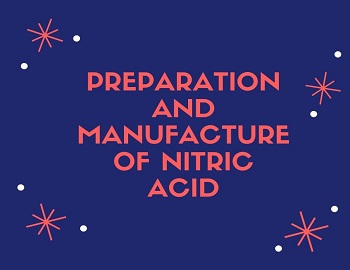Table of Contents
Preparation and Manufacture of Nitric Acid:
Nitric acid is the most important acid of nitrogen. It is an important industrial acid. It is a highly useful laboratory reagent.
Preparation of Nitric Acid:
In the laboratory, nitric acid is prepared by heating a mixture of sodium or potassium nitrate and concentrated sulfuric acid.
| NaNO3 + H2SO4 ———-> NaHSO4 + HNO3 KNO3 + H2SO4 ———-> KHSO4 + HNO3 |

Method- Take 20-30 grams of NaNO3 or KNO3 in a retort and add to it concentrated H2SO4 by means of a funnel so as to cover the sodium or potassium nitrate. Now shake the retort and fit it in a stand. Heat the retort gently at first and then more strongly with the help of the Bunsen burner. The vapours of acid are evolved. These vapours are condensed in the receiver cooled under cold water to a light brown liquid. The brown colour is due to oxides of nitrogen dissolved in it.
Manufacture of Nitric Acid:
Nitric acid is obtained commercially by the following methods-
- Birkland and Eyde Process.
- Ostwald’s Process.
Birkland and Eyde Process:
The theory of this process involves the following steps-
Nitrogen and oxygen of air are made to combine under the influence of an electric arc at 3000-3500°C to give nitric oxide.
| N2 + O2 ⇌ 2NO – 43.2 K.cals |
Nitric oxide is cooled to 140°C and it reacts with oxygen to yield nitrogen dioxide (NO2).
| 2NO + O2 ———-> 2NO2 |
Nitrogen dioxide is dissolved in water in the presence of oxygen to yield nitric acid.
| 4NO2 + O2 + 2H2O ———-> 4HNO3 |
Process- In this process, nitrogen and oxygen of air are made to react at a high temperature 3000-3500°C of an electric arc to give nitric oxide. This nitric oxide then reacts with the oxygen of the air to give nitrogen dioxide. The latter when dissolved in water in the presence of oxygen leads to the formation of nitric acid.
The Birkland and Eyde Process is not very much in use these days.
Ostwald’s Process:
This is the modern process for the manufacture of nitric acid. The theory of this process involves the following steps-
Ammonia is oxidized to nitric oxide by mixing with an excess of oxygen and then passing the mixture over a heated platinum gauge at 800°C.
| 4NH3 + O2 ———-> 6H2O + 4NO |
Nitric oxide, after cooling, is oxidized by oxygen of the air to nitrogen dioxide.
| 2NO + O2 ———-> 2NO2 |
Nitrogen dioxide is then dissolved in water in the presence of oxygen to yield nitric acid.
| 4NO2 + O2 + 2H2O ———-> 4HNO3 |
Process- In this process, nitric acid is obtained by oxidation of NH3 to nitric oxide by oxygen of air in the presence of platinum gauge as a catalyst, heated electrically to about 800°C. Nitric oxide is further oxidized to nitrogen dioxide by the oxygen of the air. Nitrogen dioxide is dissolved in water in the presence of oxygen to give rise to the formation of nitric acid.

This process is extensively used in the industry for the manufacture of nitric acid these days.









Comments (No)